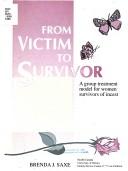| Listing 1 - 10 of 52 | << page >> |
Sort by
|
Book
ISBN: 0415622174 9780415622172 Year: 2014 Publisher: Abingdon: Routledge,
Abstract | Keywords | Export | Availability | Bookmark
 Loading...
Loading...Choose an application
- Reference Manager
- EndNote
- RefWorks (Direct export to RefWorks)
"Adopting an explicitly feminist perspective, the book argues that law must be looked at holistically, and will investigate how the legal responses presuppose, maintain and perpetuate a certain context that may in fact not reflect women's experiences. Examples of law reform in the area of violence against women and its implementation will illustrate both the overt and the 'hidden gender' of so-called neutral or objective legal principles and structures. Drawing upon a range of material primarily from Australia and England/Wales but also from the US, Canada and European countries, the book highlights the indeterminacy of the legislation and how that translates into decision-making. Consequently, Carline and Easteal analyse the application and efficacy of the law. Through contextualizing and critiquing relevant legislation, case law, and studies into the legal system, as well as comparing violence against women and policy responses, Shades of Grey will assist law-makers, academics, policy-makers and a wider audience in understanding the complexities of violence against women and the potential and the limits of law. The book does even more though; both explicitly and implicitly it provides suggestions for best practice models for policy-making and law reform. It is intended that the book will help to improve the government, community and legal responses to women who experience violence. Contextual and comparative information is an invaluable source of the knowledge and ideas needed to deal more effectively with this global public health and human rights issue"--
Women --- Abused women --- Women --- Abused women --- Women --- Abused women
Book
ISBN: 9782228924481 2228924482 Year: 2019 Publisher: Paris : Payot Graphic,
Abstract | Keywords | Export | Availability | Bookmark
 Loading...
Loading...Choose an application
- Reference Manager
- EndNote
- RefWorks (Direct export to RefWorks)
e ne veux pas être forte. Je ne veux pas être courageuse. Je veux retrouver ma légèreté. Lucie dort avec un couteau. Tamara se bat, se débat, s'anesthésie. Nicole, elle, choisit de s'effacer. Ces trois femmes ont été victimes de violences sexuelles. En réaction, elles s'inscrivent dans un atelier d'escrime thérapeutique. Un programme d'un an pour se libérer et reprendre la maîtrise de sa vie. Attaquer, se protéger, toucher. Sous les masques, la réparation peut s'amorcer.
Abused women --- Fencing --- Occupational therapy

ISBN: 9780814204665 081420466X Year: 1989 Publisher: Columbus (Ohio): Ohio State University press,
Abstract | Keywords | Export | Availability | Bookmark
 Loading...
Loading...Choose an application
- Reference Manager
- EndNote
- RefWorks (Direct export to RefWorks)
Self-defense (Law) --- Abused women --- Homicide
Book
ISBN: 0932288790 9780932288790 Year: 2000 Publisher: Amherst (Mass.): University of Massachusetts,
Abstract | Keywords | Export | Availability | Bookmark
 Loading...
Loading...Choose an application
- Reference Manager
- EndNote
- RefWorks (Direct export to RefWorks)
Social sciences --- Participant observation --- Feminism --- Abused women
Book
ISBN: 9781773631882 1773631888 Year: 2020 Publisher: Halifax: Fernwood Publishing,
Abstract | Keywords | Export | Availability | Bookmark
 Loading...
Loading...Choose an application
- Reference Manager
- EndNote
- RefWorks (Direct export to RefWorks)
"Immigrant women are not only at greater risk of experiencing domestic violence but they also under-utilize mainstream services because their needs are not adequately met there. Understanding their situation involves recognizing that their views and experiences of domestic violence are influenced by the intersections of gender, race, class and immigration. Immigrant women may not access these services because they are unavailable in their community or the women are not aware of the services, or because the services and intervention strategies are not linguistically and culturally appropriate, portable, or coordinated with other services. As a result, the outcomes and solutions provided are often compromised and unsatisfactory. Many immigrant women stay in the abusive relationship, essentially hiding in plain sight, due to the inadequate support available and despite the extraordinary efforts of many service providers. Based on interviews with service providers from the immigration, criminal justice and family justice systems in four different communities in BC, Hiding in Plain Sight examines the barriers encountered by abused immigrant women across Canada as they seek services and support, and identifies the key challenges for abused immigrant women accessing services as well as the struggles service organizations experience in meeting their needs."--
Book
ISBN: 9782343204451 2343204454 Year: 2020 Publisher: Paris : L'Harmattan,
Abstract | Keywords | Export | Availability | Bookmark
 Loading...
Loading...Choose an application
- Reference Manager
- EndNote
- RefWorks (Direct export to RefWorks)
L'auteur, fidèle à sa clinique, va à contresens des représentations actuellement liées aux violences faites aux femmes. Il dévoile une autre scène sur laquelle celles-ci se construisent entre un destin singulier et une vie de couple. Il fait le lien entre l'infiniment petit et invisible du psychisme individuel et la dimension politique et sociale qui produit quotidiennement de la violence. Ce livre nous emmène dans un voyage troublant, émaillé de nombreux témoignages de femmes et d'hommes, acteurs des violences.
Marital violence --- Violence in women --- Abused women --- Man-woman relationships

ISBN: 9780662984559 0662984552 Year: 1993 Publisher: Ottawa: Ministère de la santé. Division de la prévention de la violence familiale,
Abstract | Keywords | Export | Availability | Bookmark
 Loading...
Loading...Choose an application
- Reference Manager
- EndNote
- RefWorks (Direct export to RefWorks)
Adult child sexual abuse victims --- Incest victims --- Abused women
Book
ISBN: 0660596334 9780660596334 Year: 1994 Publisher: Ottawa: Ministre des approvisionnements et services (Canada),
Abstract | Keywords | Export | Availability | Bookmark
 Loading...
Loading...Choose an application
- Reference Manager
- EndNote
- RefWorks (Direct export to RefWorks)
Women --- Violence --- Abused women --- Community organization --- Social action

ISBN: 2213609519 9782213609515 Year: 2001 Publisher: Paris: Fayard,
Abstract | Keywords | Export | Availability | Bookmark
 Loading...
Loading...Choose an application
- Reference Manager
- EndNote
- RefWorks (Direct export to RefWorks)
Abused women --- Women --- Trials (Offenses against the person)
Book
ISBN: 1138700355 9781138700352 Year: 2018 Publisher: Abingdon: Routledge,
Abstract | Keywords | Export | Availability | Bookmark
 Loading...
Loading...Choose an application
- Reference Manager
- EndNote
- RefWorks (Direct export to RefWorks)
This edited collection addresses intimate partner violence, risk and security as global issues. Although intimate partner violence, risk and security are intimately connected they are rarely considered in tandem in the context of global security. Yet, intimate partner violence causes widespread physical, sexual and/or psychological harm. It is the most common type of violence against women internationally and is estimated to affect 30 per cent of women worldwide. Intimate partner violence has received significant attention in recent years, animating political debate, policy and law reform as well as scholarly attention.In bringing together a range of international experts, this edited collection challenges status quo understandings of risk and questions how we can reposition the risk of IPV, and particularly the risk of IPH, as a critical site of global and national security. It brings together contributions from a range of disciplines and international jurisdictions, including from Australia and New Zealand, United Kingdom, Europe, United States, North America, Brazil and South Africa.The contributions here urge us to think about perpetrators in more nuanced and sophisticated ways with chapters pointing to the structural and social factors that facilitate and sustain violence against women and IPV. Contributors point out that states not only exacerbate the structural conditions producing the risks of violence, but directly coerce and control women as both citizens and non-citizens. States too should be understood as collaborators and facilitators of intimate partner violence. Effective action against intimate partner violence requires sustained responses at the global, state and local levels to end gender inequality. Critical to this end are environmental issues, poverty and the divisions, often along 'race' and ethnic lines, underpinning other dimensions of social and economic inequality.
Intimate partner violence --- Family violence --- Women --- Abused women
| Listing 1 - 10 of 52 | << page >> |
Sort by
|

 Search
Search Feedback
Feedback About UniCat
About UniCat  Help
Help News
News